Greener energy for the future
MICROBIAL FUEL CELLS
Research overview
Microbial fuel cells (MFCs) are emerging as promising green energy systems that utilize microorganisms to generate electricity by oxidation of organic substrates during the metabolic processes. The microorganisms can extract chemical energy from the substrate and convert it into electricity in the forms of electrons and protons along with some valuable byproducts such as gaseous fuels like hydrogen and methane.
We are working on the project “Development of practical and high-performance biofuel cells.” Our research group is focusing on (i) hybrid biofuel cells, (ii) microorganism handling, (iii) biofuel cell configurations, and (iv) electrode material modification.
(i) We have studied a hybrid biofuel cell, in which the performance of yeast-based MFCs was improved by adding alcohol and aldehyde dehydrogenase enzymes directly to the anode compartment. This hybrid biofuel cell has demonstrated promising results and positive performance.
(ii) Various electroactive microorganisms were used as biocatalysts in MFCs, such as yeast, E. coli, Bacillus subtilis, and R. palustris.
(iii) Regarding biofuel cell configurations, our research group has developed some types of configurations, such as double-chamber box-type, paper-based type, and compact portable type.
(iv) Electrode material modification techniques are also important in biofuel cell research. Therefore, our research group has investigated and fabricated effective materials for enhancing the performance of biofuel cells. Environmentally-friendly carbon-based materials, such as multiwalled carbon nanotube sheets and activated carbon sheets, have been utilized for fabricating low-cost but high-performance bioanode or cathode electrodes.
We are working on the project “Development of practical and high-performance biofuel cells.” Our research group is focusing on (i) hybrid biofuel cells, (ii) microorganism handling, (iii) biofuel cell configurations, and (iv) electrode material modification.
(i) We have studied a hybrid biofuel cell, in which the performance of yeast-based MFCs was improved by adding alcohol and aldehyde dehydrogenase enzymes directly to the anode compartment. This hybrid biofuel cell has demonstrated promising results and positive performance.
(ii) Various electroactive microorganisms were used as biocatalysts in MFCs, such as yeast, E. coli, Bacillus subtilis, and R. palustris.
(iii) Regarding biofuel cell configurations, our research group has developed some types of configurations, such as double-chamber box-type, paper-based type, and compact portable type.
(iv) Electrode material modification techniques are also important in biofuel cell research. Therefore, our research group has investigated and fabricated effective materials for enhancing the performance of biofuel cells. Environmentally-friendly carbon-based materials, such as multiwalled carbon nanotube sheets and activated carbon sheets, have been utilized for fabricating low-cost but high-performance bioanode or cathode electrodes.
Current research topics
1. Paper-based MFC: development of paper-based MFCs with on-demand power-generation chracteristics.
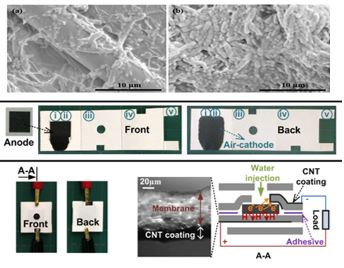
Figure 1. Developed paper-based MFC.
(“A disposable water-activated paper-based MFC using dry E. Coli biofilm,” DT Nguyen and K Taguchi, Biochemical Engineering Journal, Elsevier, 143, 161–168, 2019.)
2. Froating MFC (FMFC): Developing MFCs that can float on rivers or lakes
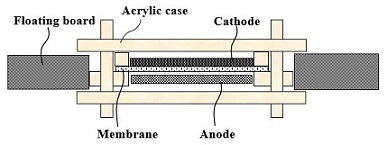
Figure 2. FMFC configuration.
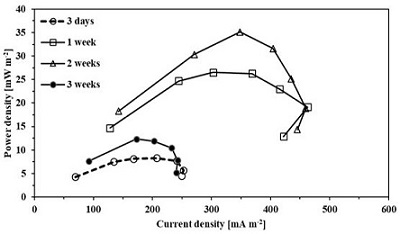
Figure 3. The experimental result of an developed FMFC.
3. Soil-based MFC (SMFC): Developing MFCs that can generate electricity from soil
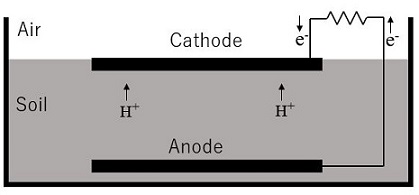
Figure 4. An illustration of SMFC.
4. Electrode materials: Synthesizing and fabricating low-cost materials to use as the anode and cathode electrodes to improve the performance of MFCs
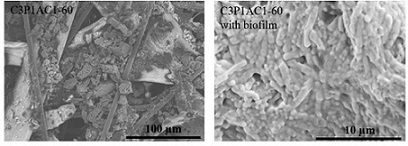
Figure 5. The SEM images of the activated carbon sheet and biofilm.
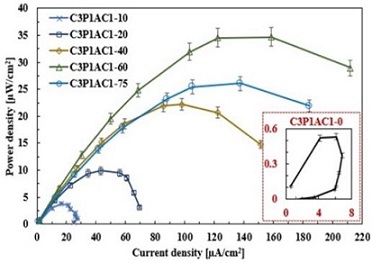
Figure 6. The power density of the MFC with different anodic materials.
(“Enhancing the performance of E. coli-powered MFCs by using porous 3D anodes based on coconut activated carbon,” DT Nguyen and K Taguchi, Biochemical Engineering Journal, Elsevier, 151, 107357, 2019.)

Figure 1. Developed paper-based MFC.
(“A disposable water-activated paper-based MFC using dry E. Coli biofilm,” DT Nguyen and K Taguchi, Biochemical Engineering Journal, Elsevier, 143, 161–168, 2019.)
2. Froating MFC (FMFC): Developing MFCs that can float on rivers or lakes

Figure 2. FMFC configuration.

Figure 3. The experimental result of an developed FMFC.
3. Soil-based MFC (SMFC): Developing MFCs that can generate electricity from soil

Figure 4. An illustration of SMFC.
4. Electrode materials: Synthesizing and fabricating low-cost materials to use as the anode and cathode electrodes to improve the performance of MFCs

Figure 5. The SEM images of the activated carbon sheet and biofilm.

Figure 6. The power density of the MFC with different anodic materials.
(“Enhancing the performance of E. coli-powered MFCs by using porous 3D anodes based on coconut activated carbon,” DT Nguyen and K Taguchi, Biochemical Engineering Journal, Elsevier, 151, 107357, 2019.)
